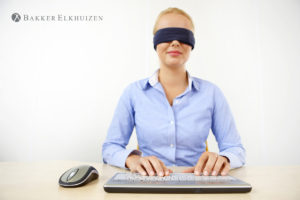 Employee burnout is something that every organisation in every country has to deal with. Burnout is the condition of mental exhaustion that follows prolonged stress. In the Netherlands it is the top occupational disease, and in our neighbouring countries too it is an issue that does not go unnoticed. Several countries have charted the general and economic consequences of burnout among workers and what it means for their mental and physical condition. How can organisations and their employees prevent it? Are there tools that can help employees find the right work-life balance, as well as keep things calm during work and monitor the amount of pressure?
Employee burnout is something that every organisation in every country has to deal with. Burnout is the condition of mental exhaustion that follows prolonged stress. In the Netherlands it is the top occupational disease, and in our neighbouring countries too it is an issue that does not go unnoticed. Several countries have charted the general and economic consequences of burnout among workers and what it means for their mental and physical condition. How can organisations and their employees prevent it? Are there tools that can help employees find the right work-life balance, as well as keep things calm during work and monitor the amount of pressure?
In the UK: In the United Kingdom, 526,000 people experienced burnout, work stress and/or an anxiety disorder in 2017. This implies a loss of 12.5 million working days. In addition, 49% of all sick days can be ascribed to mental exhaustion. A report from 2014 suggests that this disease costs 4.5% of the British gross domestic product.
What is the difference between stress and burnout? Burnout and excessive stress are often intermingled. But what differentiates burnout from stress? One could say that burnout can often be an effect of stress. If stress is bothering us, it always points to an excess. We ask too much of ourselves, physically and mentally, but often have the idea that in the end we will be in control of it. Burnout, by contrast, often means ‘not enough’. With burnout we speak of a lack of motivation: it’s not going to get better. People with burnout tend to see no positive changes to their situation.
- Less physical energy – Prolonged exposure to stress can exhaust a person physically, so people feel constantly tired and do not have the same energy they used to.
- Emotional exhaustion – People become very impatient, are in a bad mood, are more easily frustrated with things that are normal, or feel sad for no clear reason.
- Low resistance – When people are stressed, their immune system is one part of the body that is very much affected. People suffering from burnout usually get a message from their body that something has to change, making them more sensitive to colds, the flu and other diseases.
- Neglecting personal relationships – People with burnout often retreat from personal relationships.
- More pessimistic thinking – When people have burnout it is hard to get excited about things, expectations of good things happening wane, and it is difficult to put negative events behind.
- Working more inefficiently – For people with burnout it is already difficult to get out of bed, let alone do their best at work.
What causes burnout? Burnout has different causes – sometimes private or personality-related, sometimes work-related.
- Unclear goals – A company’s lack of clarity about how employees can perform well. This makes it difficult for employees to trust their abilities and feel self-confident. They will not enjoy their work as much and may miss the feeling that they are performing their work well. Other causes of burnout can be a vague or poorly explained description of tasks, constantly changing demands and unclear expectations.
- Impossible goals – Set goals can also be unrealistic, in which case it is impossible to meet them. For example, employees often become frustrated and stressed when they have to do too much and do not have enough time to perform their tasks well. They will work hard but will not feel they are succeeding, which may increase the chances of burnout.
- Too much stress, little rest – Not every job or function can be done within a 9-to-5 time frame. This is not a problem as long as the need for extra input is recognised. When this is the case, employee motivation will rise. But when extra input is constantly expected and workers have no time to catch their breath, things can get problematic.
- Consequences of mistakes – People make mistakes, that’s just the way it is. But when the consequences of making a mistake are major (such as a lawsuit), work becomes more stressful. It should therefore not be surprising that medical personnel are at a higher risk of burnout.
- No control – Independence is important. Employees often feel enthusiastic and motivated when they can make creative decisions and when they themselves can solve problems. Unfortunately, some people have no opportunity whatsoever to decide anything, which poses a greater risk of burnout.
- Too little recognition – Giving a compliment, expressing appreciation. These are relatively simple ways to give people recognition for what they do. It is not about big prizes or bonuses: a pat in the back will often do. A negative atmosphere ensues if people are only addressed whenever something doesn’t go well.
- Poor communication – Mutual communication is often underestimated. Problems in a company can be caused or enhanced by a lack of good communication. Issues such as unclear goals and insufficient recognition are aggravated by poor communication. Frustrations can occur when someone has a problem but feels that they cannot discuss this problem at work.
Recovering from burnout: In the end we all recover: some from work, others from illness, and others from a week of hard work. So if you want to have a lot of energy left, it would be useful to find out more about how recovery works. Imagine a top athlete who eats unhealthily every day and goes to bed late. What do you think will happen to this athlete’s performance? Most probably this person is not a top athlete anymore. An athlete who wants to perform at the top of his abilities sleeps enough, eats right, and keeps training to get better.
What is the best way to recover from burnout? The sports world has a common term, ‘supercompensation’. This means that after a training an athlete recovers, in order to rise above his old level. Supercompensation is a term that is used only in sports, but the same could also apply for our mental and physical condition. Do you recognise the fatigue after making a deadline at work? When you come home, you could use a few days off. Your body is telling you that it would like to recover. If you follow the signals, everything turns out okay. But if you go back to work too soon because your environment is demanding it or because you are demanding it of yourself, in the end you will break.
When you hit bottom, you have burnout – or as we say in sports, you are overtrained. You fall into a black hole, the consequences of which you only notice once you have calmed down. The body takes over in such cases.
Time to act You have burnout, you are afraid you will get it, or you want to prevent it. What can you yourself do about it? Here are a few tips: 1. Get enough sleep and rest 2. Eat a healthy and varied diet 3. Move enough, also at work 4. Listen to yourself and trust it 5. Maintain social contacts.
Conclusion We began by stating that work-related stress/burnout has a major impact on organisations and workers in Europe. It remains a topic of discussion in the various countries, and every country deals with it in its own way. In the United Kingdom the topic is discussed in relation to specific professional groups (medical personnel, social workers, public services).
About BakkerElkhuizen and our WORK & MOVE employee well-being software At BakkerElkhuizen we believe that prolonged stable concentration is a myth, and that prolonged sitting is the cause of many health problems. If an employer expects a worker to sit and work with full concentration for a lengthy period of time, negative effects are bound to be seen in the short and the long term: more mistakes, less productivity, less concentration, less creativity, more stress complaints and higher percentages of sickness absenteeism.
We recognise that workers have to regularly recharge their batteries. And this is why BakkerElkhuizen is implementing a new behavioural change programme: a smart software tool that uses dynamic ‘nudges’ to invite your employee to move, introduces variation in sit/stand moments, and offers cognitive pitstops.
With WORK & MOVE employees work more efficiently and their employability will be more lasting and vital. Additional benefits of this software are: 1) the entire organisation can be reached (in in one go). 2) individual employees can customise the setup of the digital coach. 3) performance feedback (mouse use, shortcuts, follow-up). 4) link with LogicLink and Linak; this is how a large portion of the sit-stand desks are supported by our software. 5) workspace passport: you always have the right settings with you. And for the future: 6) a reporting tool.
Interested? You can request a free trial version Here from BakkerElkhuizen.
 CIE Components in Electronics
CIE Components in Electronics


